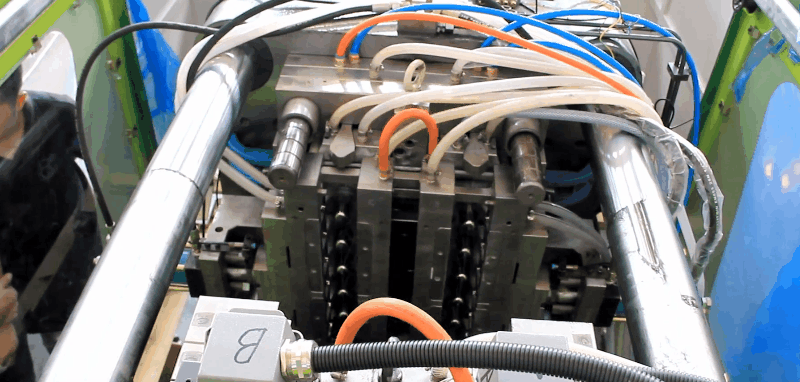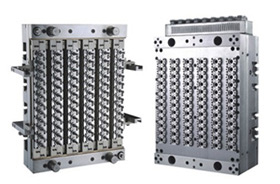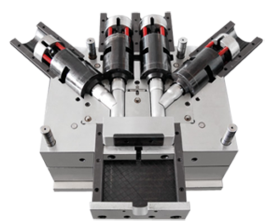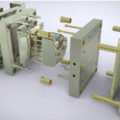Precautions for the Electric System of Toshiba Injection Molding Machines (1) Electric construction for auxiliary equipment Do not feed power source to any auxiliary equipment from the secondary circuit of main breaker in the electric cabinet of the injection molding machine. Feeding source from electric circuit of the machine will be the cause of a fire and machine malfunctions. (2) Grounding the machine and control cabinet Ensure that the machine frame and control cabinet is grounded and that connections are not corroded. Regularly exercise extreme care to avoid short-circuiting. (3) Maintenance, inspection, and connector removing Be sure to turn off the power before maintenance or inspection of electric circuit or removing the connectors. Failure to comply can cause a serious accident resulting in injury or death. (4) Inspection for heater wiring Ensure that the heater wiring is not loose and that bare wires are not exposed. Be sure to turn off the power and measure voltage at inspection points to ensure that the power is off before inspection. Insulate the heater wire connections with heat-resistant tape. Polyvinyl tape should not
Read more →Precautions for Clamping of Toshiba Injection Molding Machines (1) Safety gate damage Damages to the transparent panel of the safety gate require immediate repair. Never remove molded products from a hole. Be sure to open the safety gate before taking out molded products. (2) During machine operation, never put your hands into the injection molding machine or around a safety gate. Never touch moving parts of the injection molding machine. (3) Do not operate the machine with safety gates, safety guards, or safety devices left removed. (4) Securely turn off the power and check that the ejector is located at the retract limit and core at the out limit before starting work on the mold. (5) Inspection for safety devices Check that safety devices function securely at starting of work or changing of workers. (6) Inspection for mold mounting bolts Check the mold mounting bolts. If the mold is not properly secured, the mold may slide or fall during the injection molding process. Extreme caution should be exercised especially during NOZZLE CONTINUOUS ADVANCE. Secure proper bolt size, number and threaded
Read more →Emergency Stop Button of Toshiba Injection Molding Machines One-piece each of emergency stop button is equipped on the operation and non-operation sides of the machine to stop the machine in an emergency. Pressing the emergency stop button turns off the servo motor and the machine. NOTE: Prior to restarting the machine after pressing the emergency stop button, turn the emergency stop button clockwise to unlock it. Press [MAN] or [SET-UP] of the OPERATION selector button on the machine controller. Then press [ON] of the PREPARATION button to restart.
Read more →Alarm Code List and Error Resetting Procedures of Toshiba Injection Molding Machines Take the proper countermeasures shown in the list below if an alarm code is displayed in the TCXMAIN module of the INJECTVISOR-S51(S50)/V50. Please notify Toshiba Machine of the alarm code and occurrence condition, if the error is not reset even after taking the countermeasures shown below. Feel Free to Contact Us if Any Questions
Read more →Mechanical Safety Device of Toshiba Injection Molding Machines The safety device is designed to secure the safety mechanically by interrupting mold closing with the opening of the safety gate. If the mechanical safety device functions as a result of mold closing with the opening of the safety gate, immediately contact your nearest service station to call service personnel for inspection on electrical devices. Opening the safety gate on the operation side rolls the guide roller and the hook that synchronizes with guide roller turns toward the link housing and fits into the groove provided on the shaft to prevent mold platen closing. Closing the safety gate on the operation side makes the guide roller return the position and the hook that synchronizes with guide roller turns away from the link housing out of the groove provided on the shaft to enable mold platen closing. NOTE: This safety mechanism does not function during mold platen opening.
Read more →Electrical Safety Device of Toshiba Injection Molding Machines The safety device is designed to secure safety by shutting off the electrical circuit with the opening of the safety gate. (1) Safety gate on the operation side The safety gate on the operation side is equipped with gate close limit switches (LS1A, LS1A1). Opening the safety gate stops every machine movement in all operation modes by limit switches. NOTE: When the safety gate is opened in [AUTO] or [SEMI-AUTO] of OPERATION mode, close the safety gate and press [START] button to restart operation. NOTE: Electromagnetic locking device (LS1A3) might be added depending on the safety standards of the country where the machines are installed. 【Machines for China】 The safety gate is locked by electromagnetic locking device all the time. To release the safety gate in all modes, keep pushing [LOCK RELEASE] button on the operation controller and open the safety gate. The safety gate is locked even if the machine power is off. 【Machines for North America, Europe】 The safety gate is locked by electromagnetic locking device during following processes. (1)Machine
Read more →Plastic PET Preform Injection Molding Troubleshooting PET preform injection molding troubleshooting is very important during the whole PET bottles making process. As the PET preforms`s quality affects a lot in the following step PET preform blowing process. It may cause failed to bottle blowing if there are pet preform defects like the moisture not match the requirement(PET heating temperature is not collect). And will will waste lots of raw material if the preforms getting yellow (over melted or burned ). Below table list is the PET preform injection molding troubleshooting guide for your further information: Above PET preform injection molding defects and remedies are base on our experience in the last 16 years. Please feel free to contact us or leave a comment below if you had meet any other problems we don`t listed. We will try our best the work out a solution once we saw your message. Feel Free to Contact Us if Any Questions
Read more →Plastic PA6 Injection Molding Process Settings Barrel temperature: Feeding area 60~90°C (70°C) Zone 1 230 to 240 ° C (240 ° C) Zone 2 230 to 240 ° C (240 ° C) Zone 3 240 ~ 250 ° C (250 ° C) Zone 4 240 ~ 250 ° C (250 ° C) Zone 5 240 ~ 250 ° C (250 ° C) Nozzle 230 ~ 240 ° C (250 ° C) The temperature in parentheses is recommended as the basic set value, the stroke utilization is 35% and 65%, and the ratio of module flow length to wall thickness is 50:1 to 100:1. Feed zone and zone 1 temperature directly affect feed efficiency, increasing these temperatures can make feed more even Melt temperature: 240 ~ 250 ° C Barrel constant temperature: 220 ° C Mold temperature: 60 ~ 100 ° C Injection pressure: 100 ~ 160MPa (1000 ~ 1600bar), if you are processing thin section long channel products (such as wire tie), you need to reach 180MPa (1800bar) Holding pressure: 50% of the injection pressure; due to the relatively fast
Read more →Plasticized polyvinyl chloride (P-PVC) Barrel temperature: feeding zone: 30~50°C (50°C) Zone 1: 140 ~ 160 ° C (150 ° C) Zone 2: 150 to 180 ° C (165 ° C) Zone 3: 160 ~ 220 ° C (180 ° C) Zone 4: 160 ~ 220 ° C (190 ° C) Zone 5: 160 ~ 220 ° C (190 ° C) Nozzle: 160~220°C (200°C) The temperature in parentheses is recommended as the basic set value, the stroke utilization is 35% and 65%, and the ratio of module flow length to wall thickness is 50:1 to 100:1. Melt temperature: 200 ~ 220 ° C Barrel constant temperature: 120 ° C Mold temperature: 30 ~ 50 ° C Injection pressure: 80 ~ 120MPa (800 ~ 1200bar) Holding pressure: 30% to 60% of injection pressure Back pressure: 5~10MPa (50~100bar) Injection speed: In order to obtain a good surface quality, the injection should not be too fast (multi-stage injection if necessary) Screw speed: set the medium screw speed, the maximum folding line speed is 0.5m / s Measuring stroke: 1.0 ~ 3.5D Residual amount: 2
Read more →Plastic PVC-U Injection Molding Process Settings PVC – unplasticized (PVC-U) Barrel Heating temperature: feeding zone: 30~50°C (50°C) Zone 1: 140 ~ 160 ° C (150 ° C) Zone 2: 165 ~ 180 ° C (170 ° C) Zone 3: 180 ~ 210 ° C (190 ° C) Zone 4: 180 ~ 210 ° C (200 ° C) Zone 5: 180~210°C (200°C) Nozzle: 180~210°C (200°C) The temperature in parentheses is recommended as the basic set value, the stroke utilization is 35% and 65%, and the ratio of module flow length to wall thickness is 50:1 to 100:1. Melt temperature: 210 ~ 220 ° C Barrel constant temperature: 120 ° C Mold temperature: 30 ~ 60 ° C Injection pressure: 80 ~ 160MPa (800 ~ 1600bar) Holding pressure: can not be set too high, 40 to 60% of injection pressure, based on modules and gates Back pressure: Due to its thermal sensitivity, it is critical to set the back pressure correctly; the heat generated by the screw friction (closed heat input control) is better than the heat generated from the barrel heating
Read more →Plastic PS Injection Molding Process Settings Polystyrene (PS) Heating Temperature: Barrel temperature feeding zone: 30~50°C (50°C) Zone 1: 160 ~ 250 ° C (200 ° C) Zone 2: 200 ~ 300 ° C (210 ° C) Zone 3: 220 ~ 300 ° C (230 ° C) Zone 4: 220~300°C (230°C) District 5: 220 ~ 300 ° C (230 ° C) Nozzle: 220 ~ 300 ° C (230 ° C) The temperature in parentheses is recommended as the basic set value, the stroke utilization is 35% and 65%, and the ratio of module flow length to wall thickness is 50:1 to 100:1. Melt temperature: 220 ~ 280 ° C Barrel constant temperature: 220 ° C Mold temperature: 15 ~ 50 ° C Injection pressure: has good flow performance, avoiding excessive injection pressure of 80 ~ 140MPa (800 ~ 1400bar) Holding pressure: 30% to 60% of injection pressure; relatively short holding time Back pressure: 5~10MPa (50~100bar); in the place where the back pressure is too low, bubbles are easily generated in the melt (there are gray and black lines in the product)
Read more →Plastic PP Injection Molding Process Settings Polypropylene (PP) Heating Temperature: Barrel temperature feeding zone 30~50°C (50°C) Zone 1 160 ~ 250 ° C (200 ° C) Zone 2 200~300°C (220°C) Zone 3 220 ~ 300 ° C (240 ° C) Zone 4 220 ~ 300 ° C (240 ° C) District 5 220 ~ 300 ° C (240 ° C) Nozzle 220 ~ 300 ° C (240 ° C) The temperature in parentheses is recommended as the basic set value, the stroke utilization is 35% and 65%, and the ratio of module flow length to wall thickness is 50:1 to 100:1. Melt temperature: 220 ~ 280 ° C Barrel constant temperature: 220 ° C Mold temperature: 20 ~ 70 ° C Injection pressure: has good flow performance, avoiding excessive injection pressure of 80 ~ 140MPa (800 ~ 1400bar); Except for some thin-walled packaging containers, it can reach 180MPa (1800bar) Holding pressure: avoiding the shrinkage of the product, it takes a long time to hold the product (about 30% of the cycle time); about 30% to 60% of the injection pressure
Read more →






